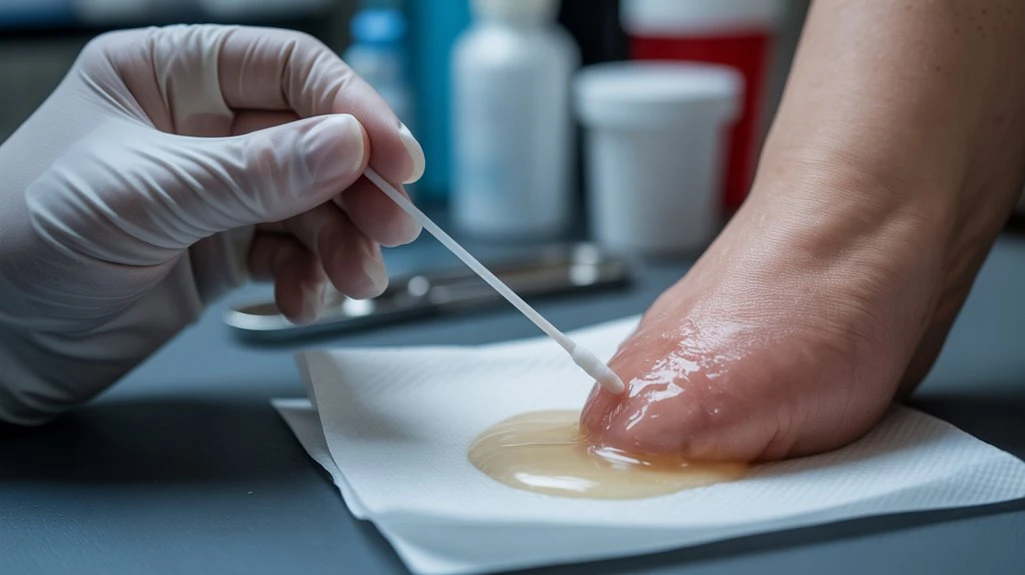For those dealing with eye-related issues such as watery eyes, TheraLife provides unique solutions. TheraLife is the only company offering oral treatment for eye care, focusing on natural and effective remedies. Their products cater to various conditions, such as blepharitis, dry eyes, uveitis, and more, by addressing root causes and promoting overall eye health. For instance, TheraLife’s approach to treating blepharitis involves natural methods that soothe symptoms and prevent recurrence, allowing users to resume daily activities without discomfort. Additionally, TheraLife’s natural treatments for dry eyes and other conditions are designed to be gentle yet effective, providing relief without the harsh side effects of conventional treatments. Exploring TheraLife’s offerings can help you identify the right solution for your specific needs, ensuring optimal eye health and comfort.
Powerful Oral Treatment for Watery Eyes – From Inside Out
Add To Cart
Key Takeaways
- Hormonal fluctuations during ovulation or perimenopause can cause clear, watery vaginal discharge due to changes in estrogen levels.
- Hormonal birth control and recent medication changes may alter vaginal discharge consistency, sometimes resulting in increased watery secretions.
- Watery discharge accompanied by odor, color changes, or irritation may indicate infections like bacterial vaginosis or trichomoniasis.
- Allergic reactions to hygiene products, soaps, or detergents can trigger watery discharge as a response to irritation.
- Persistent or abnormal watery discharge with pelvic pain or bleeding requires prompt medical evaluation to rule out underlying pathology.
Understanding Normal Vaginal Discharge

Although vaginal discharge varies throughout the menstrual cycle, normal discharge typically presents as clear or white, odorless, and of moderate amount. You should recognize that these characteristics reflect normal variations and serve as key health indicators.
Physiologically, the vagina maintains a dynamic balance of epithelial cells, mucus, and commensal flora, which contribute to the secretion’s appearance and consistency. When evaluating discharge, you’ll want to assess color, odor, consistency, and volume to distinguish between physiological and pathological findings.
Normal variations may include slight changes in texture or volume, but any persistent deviation—such as a yellow-green hue, strong odor, or significant increase—could signal infection or other pathology. By understanding these diagnostic benchmarks, you can more accurately differentiate between benign discharge and signs that warrant further clinical investigation. Proper eye hygiene is crucial for mitigating crusty eyes and associated issues.
Hormonal Fluctuations and Their Effects On Watery Eyes
You’ll notice that hormonal fluctuations greatly affect the characteristics of vaginal discharge. Changes related to your menstrual cycle, contraceptive use, and perimenopausal status can all alter volume and consistency. It’s important to correlate these variations with your clinical history to distinguish physiological patterns from pathological causes. Additionally, addressing gut inflammation through an autoimmune diet may help manage symptoms associated with hormonal changes, as inflammation can exacerbate underlying conditions.
Menstrual Cycle Influence
As hormonal levels shift throughout the menstrual cycle, the composition and volume of vaginal discharge often change in response. You’ll notice that estrogen and progesterone fluctuations directly influence secretions, with estrogen peaks typically producing a clearer, more watery discharge during ovulation.
These physiological changes help facilitate sperm motility and indicate fertile windows. However, menstrual irregularities or underlying hormonal imbalances may alter these patterns, sometimes resulting in excessive or atypical watery discharge.
Clinically, monitoring these variations can assist in distinguishing normal cyclical changes from pathologic causes. Consider the following diagnostic observations to guide assessment:
- Watery discharge peaks at mid-cycle, aligning with ovulation.
- Irregular patterns may suggest hormonal imbalances or menstrual irregularities.
- Consistent deviations from your baseline may warrant further evaluation for endocrine disorders.
An imbalance in tear production is a key factor in dry eye conditions, highlighting the importance of maintaining physiological balance in various bodily functions.
Birth Control Impact
When initiating or modifying hormonal birth control, the exogenous hormones disrupt your natural endocrine feedback, often altering the quantity and consistency of vaginal discharge.
Birth control methods such as oral contraceptives, implants, patches, and injections deliver synthetic estrogen and/or progestin, which suppress your endogenous hormonal balance. This often leads to increased watery discharge due to changes in cervical mucus production.
Clinically, you may notice a thinner, clearer discharge, which is a benign side effect of these hormonal fluctuations.
If you observe an abrupt change in discharge characteristics—such as malodor, pruritus, or color shift—consider evaluation for infection or other pathology.
It’s important to differentiate normal physiologic changes attributed to hormonal modulation from symptoms indicative of infection or gynecologic disorder when evaluating discharge.
Patients with Sjögren’s syndrome often experience dryness, including reduced saliva and tear production, which can complicate the diagnosis of other conditions.
Perimenopause and Discharge
While hormonal contraceptives externally modulate reproductive hormones, perimenopause introduces endogenous hormonal fluctuations that can significantly impact vaginal discharge patterns.
During perimenopause, declining estrogen and erratic ovulatory cycles often alter the composition and volume of vaginal secretions. You may notice watery discharge as a result of these hormonal changes, which is a common perimenopause symptom.
Clinically, it’s essential to distinguish this physiologic discharge from pathological causes such as infection or atrophy.
Key diagnostic points to take into account:
- Vaginal discharge often correlates with other perimenopause symptoms like irregular menses, hot flashes, or sleep disturbances.
- Hormonal changes can cause both increased and decreased vaginal lubrication, impacting discharge characteristics.
- Evaluation should rule out infectious etiologies or malignancy if discharge is accompanied by odor, pruritus, or abnormal bleeding.
Additionally, hormonal fluctuations during perimenopause can contribute to dry eyes and other systemic effects, necessitating a comprehensive evaluation of symptoms.
Accurate assessment guarantees ideal management.
Ovulation and Fertile Window Discharge On Watery Eyes
During ovulation, you may notice a clear, elastic, and watery cervical discharge, which reflects peak fertility. This type of secretion typically occurs midway through your menstrual cycle. It’s important to differentiate fertile cervical mucus from other vaginal fluids, as its consistency and timing can aid in identifying ovulatory patterns. Additionally, environmental factors like allergens can also affect eye moisture levels, contributing to watery eyes during certain periods.
Characteristics of Fertile Discharge
Recognizing the features of fertile discharge is essential for identifying the ovulatory window because the characteristics of cervical mucus fluctuate throughout the menstrual cycle.
If you’re practicing fertility awareness, you’ll notice that discharge patterns offer valuable diagnostic clues. Fertile discharge, commonly referred to as egg white cervical mucus (EWCM), is typically clear, stretchy, and slippery, enhancing sperm motility and survival.
Clinical studies confirm these properties are most prominent when estrogen peaks, signaling peak fertility. To differentiate fertile discharge from other causes of watery secretions, assess for these evidence-based characteristics:
- Clear, transparent, and resembles raw egg whites in consistency
- Stretchy, allowing you to pull it between your fingers without breaking
- Increased volume and lubrication, facilitating sperm transport
Monitoring these traits supports accurate identification of your fertile window. Chronic dry eyes can also lead to watery eyes, which are part of the complications often associated with dry eye syndrome.
Timing Within Menstrual Cycle
As estrogen levels rise in the days leading up to ovulation, cervical mucus undergoes marked changes that indicate the fertile window. During this phase, you’ll often notice an increase in watery, clear, or stretchy discharge, which reflects ideal conditions for sperm motility and fertilization. These alterations directly correspond with hormonal changes, specifically the surge in luteinizing hormone and peak estrogen, signaling imminent ovulation. By tracking symptoms such as the volume, consistency, and appearance of discharge, you can accurately identify this fertile period within your menstrual cycle. Clinically, the presence of copious watery discharge between days 10–16 of a typical 28-day cycle is a reliable diagnostic marker of ovulatory activity. Monitoring these cyclical changes allows for precise timing in fertility assessments or contraceptive planning. Additionally, eyelid inflammation such as blepharitis can be managed effectively with proper treatment and hygiene, allowing individuals to return to activities like wearing eye makeup once symptoms are under control.
Distinguishing From Other Fluids
While tracking cyclical changes in discharge can pinpoint ovulation, it’s important to distinguish ovulatory cervical mucus from other bodily fluids such as semen, arousal fluid, or pathological discharge. Each fluid type presents with unique characteristics.
Ovulatory discharge is typically clear, stretchy, and resembles raw egg whites, indicating the fertile window. In contrast, arousal fluid is slippery but less elastic, and semen is usually opaque and may dry white or yellow.
Pathological discharges often exhibit abnormal discharge colors (yellow, green, gray) and may be accompanied by odor or irritation. Watery discharge is often linked to blocked tear ducts, which is different from ovulatory discharge as it is associated with eye conditions rather than reproductive cycles.
- Ovulatory mucus: Clear, elastic, egg-white consistency, no odor.
- Arousal fluid: Slick, watery, less stretch, no persistent residue.
- Pathological discharge: Altered colors, foul odor, associated symptoms.
Accurate identification of these fluid types supports better reproductive and diagnostic decision-making.
Signs of Infection to Watch For

Even mild watery discharge can signal infection when accompanied by specific clinical indicators. Closely monitor changes in discharge clarity, as a shift from transparent to cloudy or malodorous secretions may indicate bacterial vaginosis or trichomoniasis.
You should assess for pruritus, vulvar irritation, erythema, and dysuria—these symptoms often point to compromised vaginal health due to infection. Additionally, notice any pelvic discomfort or abnormal bleeding, as these can accompany cervicitis or sexually transmitted infections.
The presence of fever or systemic symptoms requires prompt evaluation. Clinical evidence highlights that persistent watery discharge, especially when associated with these warning signs, warrants diagnostic testing such as wet mount microscopy, pH assessment, and nucleic acid amplification tests. Chlamydia infections can also lead to chlamydial conjunctivitis, causing symptoms like redness and swelling of the eyes when genital infection spreads or through direct contact with infected fluids.
Early identification optimizes treatment outcomes and preserves vaginal health.
Impact of Birth Control and Medications
Although hormonal fluctuations play a key role in vaginal secretions, birth control methods and certain medications can directly alter the volume and consistency of watery discharge.
Different birth control types—such as combined oral contraceptives, progestin-only pills, and hormonal IUDs—impact cervical mucus production. You might notice an increase or decrease in watery secretions depending on the hormonal content and mechanism.
Medication effects also contribute; for example, some antibiotics and steroids can disrupt vaginal flora or hormonal balance, leading to altered discharge characteristics.
When evaluating watery discharge, always consider recent changes in:
- Birth control types (oral, injectable, implantable, or IUD)
- Medication effects (antibiotics, steroids, antihistamines)
- Initiation or cessation of hormonal therapy
Clinical assessment should include a thorough medication and contraceptive history to identify iatrogenic causes.
Sexually Transmitted Infections as a Cause
Since certain sexually transmitted infections (STIs) can directly affect the vaginal environment, it’s important to evaluate their potential role in causing watery discharge.
Common STIs such as chlamydia, gonorrhea, and trichomoniasis often present with changes in vaginal secretions, including an increase in clear or watery discharge.
For accurate diagnosis, you should undergo nucleic acid amplification tests (NAATs), which offer high sensitivity and specificity for detecting these pathogens.
Early identification is vital, as untreated infections can lead to complications such as pelvic inflammatory disease.
Treatment options typically include antibiotic therapy tailored to the specific organism identified.
It’s also essential to inform sexual partners and complete the full course of prescribed medication to prevent recurrence and further transmission.
Regular screening remains a key preventive measure.
Allergies, Irritants, and Sensitivities on Watery Eyes

Exposure to certain chemicals, fragrances, or hygiene products can trigger localized allergic reactions or sensitivities, resulting in watery vaginal discharge.
When your body encounters environmental triggers—such as dyes, detergents, or latex—it may respond with inflammation in the vaginal mucosa. This immune response often leads to increased watery secretions as the body attempts to flush out the irritant.
You should consider the following potential environmental triggers if you notice a sudden change in discharge:
- Scented soaps, bubble baths, or feminine sprays
- Laundry detergents or fabric softeners with added fragrances
- Condoms or personal lubricants containing latex or parabens
Clinically, allergic reactions and sensitivities usually present without systemic symptoms like fever.
Diagnostic evaluation should focus on recent product exposures, detailed history, and the exclusion of infectious causes. Discontinuing suspected irritants often resolves symptoms.
When Watery Discharge Signals a Medical Issue
While many cases of watery vaginal discharge relate to benign irritants or sensitivities, persistent or unusual changes may indicate an underlying medical condition.
You should pay close attention to variations in discharge colors and discharge textures. Clear, watery discharge is often physiologic, but when accompanied by yellow, green, gray, or blood-tinged hues, it may signal infection or pathology.
Similarly, discharge textures that become frothy, curd-like, or unusually thin can suggest bacterial vaginosis, trichomoniasis, or candidiasis.
If you also experience pruritus, malodor, pelvic pain, or systemic symptoms, diagnostic evaluation is warranted.
Clinical guidelines recommend considering sexually transmitted infections, atrophic vaginitis, or even cervical pathology when discharge changes are persistent or unexplained.
Careful symptom assessment and examination are essential for accurate diagnosis and prompt intervention.
Steps to Take If You Notice Unusual Discharge
If you detect an unusual change in your vaginal discharge, it’s important to promptly assess associated symptoms such as color, odor, consistency, and any accompanying discomfort.
Begin by documenting the onset and duration of symptoms to facilitate an accurate clinical evaluation. Consider recent lifestyle changes, including alterations in hygiene products, sexual activity, or stress levels, as these can influence vaginal flora.
Evaluate dietary impacts, as excessive sugar intake or nutritional imbalances can predispose to infections like candidiasis.
If symptoms persist beyond a few days or are accompanied by itching, burning, pelvic pain, or fever, seek medical assessment.
Meanwhile, you can:
- Monitor for progression or additional symptoms
- Refrain from using intravaginal products or douching
- Review recent lifestyle changes and dietary impacts
Early intervention supports ideal reproductive health.
Powerful Oral Treatment for Watery Eyes – From Inside Out
Add To Cart
Frequently Asked Questions
Can Stress Cause Watery Vaginal Discharge?
Yes, stress can contribute to watery vaginal discharge. When you experience stress, your body may undergo hormonal imbalance, particularly with cortisol and other stress hormones.
These hormonal shifts can alter your vaginal environment and increase secretions. It’s important for you to contemplate stress management strategies, as persistent stress may exacerbate symptoms.
If you notice ongoing changes, consult a healthcare provider to rule out infections or other underlying conditions through proper diagnostic evaluation.
Does Diet Influence Vaginal Discharge Consistency?
Have you ever considered how dietary influences might affect your vaginal discharge consistency?
Research shows that nutritional deficiencies, such as inadequate intake of vitamins A, C, and E, can disrupt vaginal mucosal integrity and secretions.
Diets high in sugar may also alter the vaginal microbiome, predisposing you to abnormal discharge.
To maintain normal physiologic secretions, guarantee a balanced diet rich in essential nutrients, which clinically supports ideal vaginal health and function.
Is Watery Discharge Common During Menopause?
Yes, you may experience watery discharge during menopause due to significant hormonal changes, especially decreased estrogen levels.
These hormonal fluctuations impact vaginal health by altering the vaginal mucosa and secretions. Clinically, you might notice either increased or decreased vaginal discharge.
It’s important for you to monitor any changes, as persistent or abnormal discharge could indicate infection or other pathology, warranting further diagnostic evaluation by your healthcare provider.
Can Dehydration Affect Vaginal Discharge?
Imagine noticing unexpected changes in your vaginal discharge—could something as simple as hydration be influencing this?
If you don’t maintain adequate fluid intake, you’ll likely see hydration effects leading to discharge changes. Clinical evidence shows dehydration can decrease vaginal secretions, resulting in less lubrication and a thicker, scantier discharge.
Monitoring your fluid status serves a diagnostic role in evaluating alterations in vaginal discharge, so always consider your hydration when examining such symptoms.
Are There Home Remedies to Manage Watery Discharge?
If you’re looking for home remedies to manage watery discharge, you can explore natural treatments like maintaining ideal genital hygiene and wearing breathable cotton underwear.
Some individuals use herbal remedies, such as tea tree oil or probiotics, although clinical evidence supporting their efficacy is limited.
Always monitor for associated symptoms like odor, itching, or irritation.
If the discharge persists or changes, seek diagnostic evaluation to rule out infections or other underlying gynecological conditions.
Powerful Oral Treatment for Watery Eyes – From Inside Out
Add To Cart
Conclusion
If you’re noticing watery vaginal discharge, it’s crucial to understand the potential causes and responses. TheraLife offers unique oral treatment products that provide comprehensive care for various eye conditions, ensuring you maintain optimal eye health. As the only company specializing in oral eye treatment, TheraLife supports customers with conditions like blepharitis, dry eyes, and uveitis, offering natural and effective solutions. Their products help eliminate symptoms such as irritation and discomfort, enabling you to manage your health confidently. For persistent or concerning symptoms, consult a healthcare professional for an accurate diagnosis and appropriate management, allowing you to enjoy peace of mind and well-being.
References
- 1.
- 2.
- Nemet AY. The Etiology of Epiphora: A Multifactorial Issue. Semin Ophthalmol. 2016;31(3):275-9. [PubMed]
- 3.
- Shen GL, Ng JD, Ma XP. Etiology, diagnosis, management and outcomes of epiphora referrals to an oculoplastic practice. Int J Ophthalmol. 2016;9(12):1751-1755. [PMC free article] [PubMed]
- 4.
- Patel J, Levin A, Patel BC. StatPearls [Internet]. StatPearls Publishing; Treasure Island (FL): Aug 7, 2023. Epiphora. [PubMed]
- 5.
- Gurnani B, Kaur K. StatPearls [Internet]. StatPearls Publishing; Treasure Island (FL): Jun 11, 2023. Bacterial Keratitis. [PubMed]
- 6.
- Basu S. Seeing through tears: Understanding and managing dry eye disease. Indian J Ophthalmol. 2023 Apr;71(4):1065-1066. [PMC free article] [PubMed]
- 7.
- Icasiano E, Latkany R, Speaker M. Chronic epiphora secondary to ocular rosacea. Ophthalmic Plast Reconstr Surg. 2008 May-Jun;24(3):249. [PubMed]
- 8.
- 9.
- Tse DT, Erickson BP, Tse BC. The BLICK mnemonic for clinical-anatomical assessment of patients with epiphora. Ophthalmic Plast Reconstr Surg. 2014 Nov-Dec;30(6):450-8. [PubMed]
- 10.
- Webber NK, Setterfield JF, Lewis FM, Neill SM. Lacrimal canalicular duct scarring in patients with lichen planus. Arch Dermatol. 2012 Feb;148(2):224-7. [PubMed]
- 11.
- Portelinha J, Passarinho MP, Costa JM. Neuro-ophthalmological approach to facial nerve palsy. Saudi J Ophthalmol. 2015 Jan-Mar;29(1):39-47. [PMC free article] [PubMed]
- 12.
- Zhang Y, Zeng C, Chen N, Liu C. Lacrimal ductal cyst of the medial orbit: a case report. BMC Ophthalmol. 2020 Sep 24;20(1):380. [PMC free article] [PubMed]
- 13.
- Kim JS, Liss J. Masses of the Lacrimal Gland: Evaluation and Treatment. J Neurol Surg B Skull Base. 2021 Feb;82(1):100-106. [PMC free article] [PubMed]
- 14.
- Lievens CW, Rayborn E. Tribology and the Ocular Surface. Clin Ophthalmol. 2022;16:973-980. [PMC free article] [PubMed]
- 15.
- Al Saleh A, Vargas JM, Al Saleh AS. Supernumerary lacrimal puncta: Case series. Saudi J Ophthalmol. 2020 Oct-Dec;34(4):328-330. [PMC free article] [PubMed]





